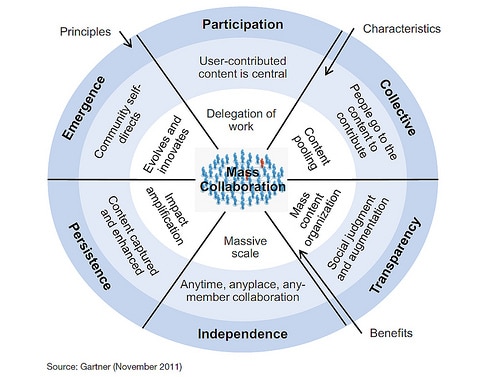According to Gartner, many business and IT leaders fail at utilizing social media effectively because they do not understand mass collaboration. They use a “provide and pray” approach, expecting online community participation to just happen. It’s just one of the reasons why communities fail.
What happens instead is that users have an initial interest and then lose that interest as they discover that the platform is too difficult to use collaboratively. Applying the six core design principles creates a better social media environment for meaningful collaboration and social community participation, Gartner says.

1. Seed, incentivize and engage
User and community participation is the driving force behind successful mass collaboration. Some companies think of social media as a one-way street, an opportunity for them to put out the information they want people to know.
The design becomes driven by this goal instead of making a social outlet where people can easily participate in the conversation and add meaningful content. Leaders should focus on giving information that seeds discussion and provide social incentives (social status, gamification techniques etc.), to join in.
2. Collective: the unifying cause of community participation
People will swarm if the purpose within the community is compelling enough to each individual personally and the timing is right. It is fairly easy to get people to join a community and visit to contribute ideas around a unifying cause. Business leaders must have a specific reason why people should collaborate and contribute to a community. This is their purpose. Their reason for community participation.
A purpose must be meaningful, identifiable and clearly defined for the target audience. Leaders should employ a “tipping point plan,” making use of events both online and in the physical world, to act as a community catalyst.
3. Transparency: from community participation to community validation
Successful social media outlets allow users to view other people’s participation. This transparency is a key difference between social media and other content sharing methods, such as knowledge management systems and Web content management. Creating an environment with transparency gives the community the ability to grow, to improve, and to self-correct.
Leaders can use tools within a transparent environment to encourage greater participation. Ratings functions, such as star ratings, classifying a post as helpful or not helpful, giving something a thumbs up or thumbs down, allow for feedback that helps to encourage better content. Allowing comment and voting are other ways to provide feedback and participation. Sharing and tagging features draw people in.
Transparency can also be used to show incentives. Badges, virtual currencies and other gamification mechanisms or recognition methods make people more likely to become active users.
4. Independence: the freedom of community participation
Gating mechanisms impede mass collaboration. Moderators or designs within a social media platform that prevent or discourage individuals from collaborating should be eliminated whenever possible.
Independence allows for anyone to participate anytime without relying on anyone else.
5. Persistence and scaled value
Another important feature of social media is the ability to capture information and interaction. A post on a social media site can be seen in its entirety and then shared or augmented. When people talk over the phone, information is not effectively captured.
Gartner recommends that companies strive to make it easy for users to capture content through evolving technologies. Companies benefit from discovering what content is critical to their purpose. They need to observe how much persistence is desired within the community as well as the quantity of contribution worth capturing.
6. Emergence and self-direction
Mass collaboration allows for behaviors to emerge gradually as users interact. In traditional systems, behaviors can be regulated and designed, but not so with mass collaboration in social media.
Allowing the communities to self-direct leads to more interaction, more ideas, and greater productivity.

